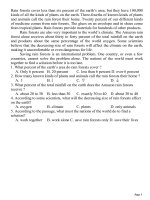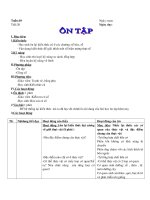20 bài reading (quetions)
Bạn đang xem bản rút gọn của tài liệu. Xem và tải ngay bản đầy đủ của tài liệu tại đây (130.63 KB, 20 trang )
Rain forests cover less than six percent of the earth’s area, but they have 100,000
kinds of all the kinds of plants on the earth. Three-fourths of known kinds of plants
and animals call the rain forest their home. Twenty percent of our different kinds
of medicine comes from rain forests. The glues on an envelope and in shoes come
from tropical plants. Rain forests provide materials for hundreds of other products.
Rain forests are also very important to the world’s climate. The Amazon rain
forest alone receives about thirty to forty percent of the total rainfall on the earth
and products about the same percentage of the world oxygen. Some scientists
believe that the decreasing size of rain forests will affect the climate on the earth,
making it uncomfortable or even dangerous for life.
Saving rain forests is an international problem. One country, or even a few
countries, cannot solve the problem alone. The nations of the world must work
together to find a solution before it is too late.
1. What percent of the earth’s area do rain forests cover ?
A. Only 6 percent B. 20 percent C. less than 6 percent D. over 6 percent
2. How many known kinds of plants and animals call the rain forests their home ?
A.
3
4
B.
4
3
C.
3
40
D.
40
3
3. What percent of the total rainfall on the earth does the Amazon rain forests
receive ?
A. about 20 to 30 B. less than 30 C. exactly 30 to 40 D. about 30 to 40
4. According to some scientists, what will the decreasing size of rain forests affect
on the earth?
A. oxygen B. climate C. plants D. only animals
5. According to the passage, what must the nations of the world do to find a
solution?
A. work together B. work alone C. save rain forests only D. save their lives
Page 1
Wild animals (and wild plants) and the wild places where they live are seriously
threatened almost everywhere. One species has become extinct in each year of this
century. But many hundreds are now in danger. Lack of attention would lead to the
rapid advance of the process of extinction.
Already many kinds of wild animals has been so reduced in number that their role
in the ecosystem is forgotten. Animals like the great apes, the whales, seals etc.
thought to be in danger of extinction.
But even more important, perhaps than individual kinds of animals and plants,
whole habitats are in danger of vanishing: marshes are being drained, and the
world forests, especially tropical forests are being cut down to satisfy man’s needs
of timber and paper.
What would our world be like if all the wild animals and wild plants
vanished? - Would our life still exist then?
1. What would happen to the human beings if the wild life vanished?
A. Many species would quickly become extinct.
B. The human life would be seriously threatened.
C. Species would go on dying out.
D. Tropical forests would be cut down.
2. What is more important than individual kinds of animals and plants?
A. the vanishing of whole habitats. B. the extinction of many species.
D. man’s need of timber and paper. C. the rapid advance of the process of
extinction.
3. What does the writer caution us against?
A. cutting down the tropical forests. B. hunting wild animals.
C. draining marshes. D. destroying our environment.
4. What would happen if we cut down forests?
Cutting down forests would cause ……………..
A. the changes of temperature. B. the flood
C. both A and B are correct. D. none are correct.
5. “To threaten” in the passage means …………..
A. to pollute B. to give fear to C. to vanish D. to poison
Page 2
In developing countries, where three fourths of the world’s population live, sixty
percent of the people who can’t read and write are women. Being illiterate doesn’t
mean they are not intelligent. It does mean it is difficult for them to change their
lives. They produce more than haft of the food. In Africa eighty percent of all
agricultural work is done by women. There are many programs to help poor
countries develop their agriculture. However, for years, these programs provided
money and training for men.
In parts of Africa, this is a typical day for a village woman. At 4:45 a.m, she
gets up, washes and eats. It takes her a haft hour to walk to the fields, and she
works there until 3:00p.m. She collects firewood and gets home at 4:00. She
spends the next hour and a haft preparing food to cook. Then she collects water for
another hour. From 6:30 to 8:30 she cook. After dinner, she spends an hour
washing the dishes and her children. She goes to bed at 9:30 p.m.
International organizations and programs run by developed nations are
starting to help women, as well as men, improve their agricultural production.
Governments have already passed some laws affecting women because of the
UNO Decade for Women. The UNO report will affect the changes now happening
in the family and society.
1. By whom (what) was the Decade for Women organized?
A. by developing countries. B. by the United Nations Organization.
C. by the World Health Organization. D. by many African countries.
2. Why do people say women produce more than haft of the food?
A. because 80 percent of all agricultural work is done by women.
B. because 60 percent of women are illiterate.
C. most women are not intelligent.
D. all are correct.
3. Why do people say that African women’s lives are hard?
A. because these women are busy with housework..
B. because they work all day in the fields.
C. both A and B are correct.
D. none are correct.
4. What do these women do after dinner?
A. they always go for a walk. B. they collect water.
C. they collect firewood. D. they always wash dishes and their children.
5. It is difficult for them to change their lives. Why?
A. because they are illiterate.
B. because they are afraid of changing.
C. because they do eighty percent of agricultural work.
D. All are correct.
Page 3
Germany had one of the lowest rates of unemployment back in 1980. It stood at
just 3%. Now the rate is increasing. The United States has had ups and downs. In
1980, it was about 1% lower than that in Germany; 7.5% in 1981; and in 1984, it
was the same rate as in 1980. Great Britain heads the employment chart. In 1980,
their situation was the same as the United States, then followed a sharp rise in
1981, when the rate was 10,5%. This rose gradually over the next two years to
13%. There was no great change until two years later people saw another increase
to about 13.5% and figures do not look as though they are on their way down yet.
1. What was the rate of unemployment in the United States in 1980?
A.2% B. 3% C. 7.5% D. 1%
2. What was the rate of unemployment in Britain in 1983?
A. 2% B. 3% C. 7.5% D.13%
3. Which country had the highest rates of unemployment?
A. Germany B. France C. The US D. Britain
4. In what year of the 1980s did Britain have the highest rate?
A. 1980 B. 1981 C. 1984 D.1985
5. In England, the rate of unemployment is __________
A. on their way down B. lowest
C. not increasing D. not on their way down
Page 4
WHY PEOPLE WORK
All of us know that we have to work hard to earn a living ourselves and to
support our family. However, we work not only for material life but also for many
things that are beyond gaining money. We are working to affirm our ability on a
certain field. We feel self-reliant, self-confident, and proud because we are
financially independent.
Anyone who works is regarded as a useful member of society. We are
working that means we are contributing useful goods and services to our country.
Working helps us train our skills and talents. We always try our best to do a good
job. The better we work, the more money we earn and that motivate us to work
harder. Without working, a man’s life will be empty, purposeless and meaningless
and it is easy for a lazy jobless man to do wrongs.
1. We have to work hard _____
A. because we are forced to B. to make our material life better
C. to make ourselves purposeless D. All are correct
2. Besides money, ________________.
A. we can get many other benefits from work
B. we can get some salary from work
C. we sometimes feel very meaningless
D. we can not contribute anything to our country
3. The more we work _____ .
A. the duller we feel B. the less we earn
C. the more we contribute to society D. A and B
4. What motivates us to work harder? - ______.
A. good job B. good pay C. good way D. good skills
5. Without working, one's life is _______.
A. better B. more confident C. self-reliant D. meaningless
Page 5
Many people discriminate one skin colour from another, especially between the
white and the black. In some states in America, the coloured people don’t have the
same rights as the white people. Coloured people are badly treated in some areas of
the world and some are even killed because of their colour.
1. What do many people discriminate?
A. colour B. skin C. hair colour D. skin colour
2. Where do the coloured people not have the same rights as the white people?
– In _____.
A. Africa B. Asia C. Australia D. some states in America
3. How are the coloured treated?
A. They are not badly treated. C. They are badly treated.
B. They are fair treated. D. They are well treated.
4. How are some other coloured people?
A. They are killed. C. They are hired.
B. They are trained. D. They are loved.
Page 6
Sean O’Casey wrote many stories, novels, plays and a great autobiography in six
volumes. In his works, he described the hard life of the Irish workers and their
struggle against the British government. He wrote about his time and himself, and
about his people as a whole. All his work were highly appreciated because of their
literary values and progress views.
Sean O’Casey died in England at the age of 84, and was well-remembered as
an active fighter for friendship, peace, solidarity and independence. His last words
at the party given on his 84
th
birthday were: I’m more of a Communist now than I
ever was…”.
3. What did he describe in his works?
A. The fight for independence from Great Britain
B. The poverty of the Irish soldiers
C. The progress views of the English government
D. The hard life of the Irish workers and their struggle against the British
government
4. Why were all his works appreciated?
A. Because of their literary values and progress views
B. Because of the hard life of the Irish workers
C. Because of the struggle for independence
D. Because of the fight against the English
5. Which of the following statements is NOT true?
A. Sean O’Casey wrote about his time and himself.
B. Sean O’Casey died at the age of 84.
C. Sean O’Casey didn’t write about his people as a whole.
D. The Irish workers fought against the British government.
6. Which of the following statements is PROBABLY true?
A. All Sean O’Casey’s works were not highly appreciated.
B. Sean O’Casey struggled against freedom.
C. Sean O’Casey was well-remembered as an active fighter
D. Sean O’Casey died in Ireland.
16. What can we assume from the passage?
A. Sean O’Casey wrote many stories, novels, plays and a great autobiography
in six volumes.
B. Sean O’Casey was an Irish writer.
C. Sean O’Casey was an active fighter for friendship, peace, solidarity and
independence.
D. Sean O’Casey was a Communist.
Page 7
Most of the people who like films are only interested in the leading actor or actress
when they enjoy a film. It seems to them that only the actors or actresses have
made the film successful. They always pay attention to
(1)
their appearance,
performance, and fashion. There are many film viewers who have no awareness
(2)
of the other people’s work to make a film. A finished film is, actually, the result of
the collaboration of many persons, and the most important among them are the
scriptwriter, the cinematographer, the film editor, the actor, and the director.
Especially, in some thrilling scenes, the roles of stuntmen
(3)
are very important.
They are always in danger
(4)
when they are acting; some of them are even badly
hurt or dead. But what a pity, many film viewers rarely appreciate their work.
1. To many film viewers, ……
A. the director is the most important
C. no one is more important than the leading actor or actress
B. the stuntmen play the most important role
D. the most important person is the cinematographer
2. Many film viewers always pay attention to ……
A. the director’s name and appearance
C. the actors’ and actresses’ appearance, performance, and fashion
B. the leading actors’ or actresses’ family
D. the pictures taken by the cinematographer
3. A finished film is the result if the collaboration of ……
A. many people B. the actors C. the actresses D. the director
4. There are …… most important individuals in making a film.
A. 3 B. 4 C. 5 D. 6
5. The work of stuntmen is ……
A. secure B. dangerous C. interesting D. thrilled
Page 8









